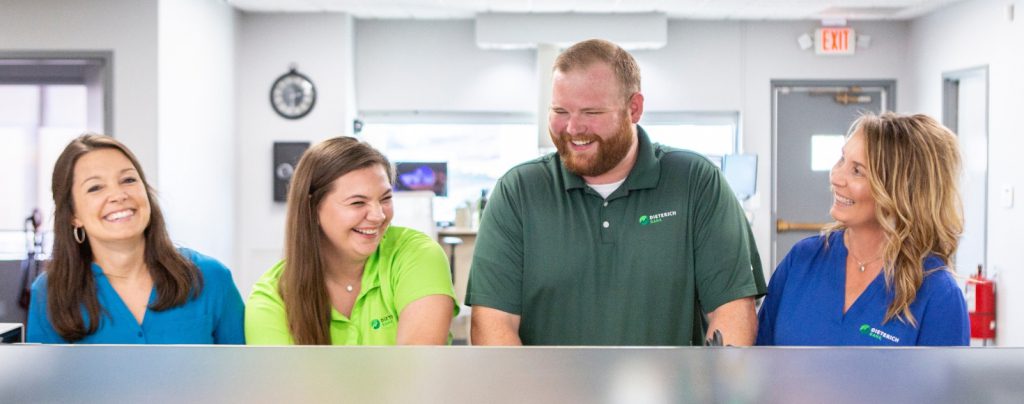With the explosive growth of online and mobile banking and transactions over the past two decades, it’s more important than ever for individuals and banks alike to take protective measures to keep their online accounts secure. In fact, in 2022 consumers reported losing nearly $8.8 billion to scams. If you or someone you know has been the victim of online fraud, you aren’t alone.
So, is online banking safe and what does cybersecurity for banks look like? While we’ve discussed cyber crime and digital security measures in previous blog posts, we wanted to use this post to take a closer look at the topic. In this post, we’ll discuss some of the things we do at Dieterich to help keep your accounts safe, as well as common techniques and terms you may encounter during your day-to-day banking practices—so that you feel better equipped to navigate digital transactions, spot fraudulent activity, and report suspicious transactions right away.
Who is at Risk for Cybersecurity Attacks?
When many of us think of victims of cybersecurity scams, we might first think of populations who are less tech-savvy—older Americans and other individuals who did not come of age with accessibility to digital technology. However, studies show that younger generations, who spend significantly more of their time online and are less likely to observe cybersecurity protocols, are also at high risk for cyber crime.
So why do we consider older populations more at risk? For one thing, they are targeted more frequently, in part due to their generally higher net worth. Additionally, when older individuals, who have accumulated more wealth over their lifetimes do fall victim, they tend to lose more, reporting their losses.
Given the fact that individuals at all stages of their lives are at risk for cybercrimes, it’s important to educate all generations about the risks they face, and how to prevent becoming a victim.
Common Cybersecurity Terms and Measures
Familiarizing yourself with the terms and common measures banks use to safeguard their customers can help you better navigate your day-to-day account usage and ensure that you make the most of the protections available to you.
Kinds of Banking Cybersecurity
In general, digital banking security measures take a four-pronged approach. These include:
- Online Banking Security: Ensuring simple but safe access to online (website) banking portals.
- Mobile Banking Security: Protecting mobile (phone) banking apps from hacking.
- Transaction Security: Safeguarding financial transactions, whether online or in person using a check or card, against fraud.
- ATM Security: Protecting ATMs from skimming and hacking.

Identity Verification: Helping Account Holders Control Every Transaction
Many banking and payment apps require that you verify that the person attempting to access your account is actually you. Always say “yes” if given the choice to activate additional identity verification measures—without them it can be more difficult to stop suspicious activity before it happens.
- Two-Factor Authentication (2FA): Beyond a simple PIN or password, which can be stolen or guessed, 2FA adds an extra layer of security for account access. This could involve entering a code sent to your phone, using an authentication app, or presenting biometric data (more on this below).
- Multi-Factor Authentication (MFA): While two-factor authentication requires one more level of verification beyond your password or PIN, MFA can require a third or even fourth form of authentication. Such measures are often reserved for the most sensitive accounts.
- Biometric Security: Biometrics can be a quick and easy way to ensure that the user that is attempting to login or complete a transaction is indeed the account holder. Biometric security can be used by itself, or as a step in 2FA or MFA. Biometric data used could include face, fingerprint, or iris scans, and is getting increasingly common with mobile devices.
One of the ways that hackers may try to gain illegal access to your account is to pose as your bank or credit card company and request that you provide a code sent to your mobile device. Know that we will never ask you for any verification codes or login credentials over the phone. If you receive a call or other communication requesting this information, deny the request and reach out to us immediately.
Methods Used to Protect Online Communication and Information
Online banking—banking using a web browser—can be more vulnerable to cyber attacks than any other form of banking. As the FDIC explains, “Phishing, pharming, spyware, malware, worms, nimdas, viruses, buffer overflows, and spam—all relatively recent entries to our vocabulary—have raised electronic/Internet banking risk levels to new highs, and financial institutions have had to increase security measures to address those risks.”
Banks effectively reduce many of these risks through two foundational measures:
- Secure Communication Channels (SCC): By using SCC, banks can protect email and messaging from interception by nefarious third parties.
- Website Security Certificates: Using SSL/TLS certificates secures access to websites and the information that you enter (like login credentials) into these sites. Always be sure that a website you are using is secure by looking for the lock symbol next to the web address in your browser bar. Additionally, many web browsers will alert you if a site is not secure.

Protecting You: Understanding How Dieterich Bank Keeps You Safe
If you’ve ever received a phone call or an alert about a transaction, you’ll know that financial institutions monitor account activity and are always on the lookout for potential fraud. Part of this is because fraud can have a huge impact on banks. In fact, in 2022 70% of banks lost at least $500,000 to fraud. Banks also operate in a highly-regulated environment, and this extends to cybersecurity. Cybersecurity protocols are not just important to protect a bank’s assets, they are also often required by law.
There are several key regulations and standards that banks like Dieterich work hard to comply with every day. Let’s take a look at a few of these to get a better understanding of the lengths we go to to protect your accounts.
The Gramm-Leach-Bliley Act (GLBA): Requires financial institutions in the United States to explain their information-sharing practices to their customers and to safeguard sensitive data.
Bank Secrecy Act/Anti-Money Laundering (BSA/AML) Compliance: Requires implementing effective systems to monitor and report suspicious activities that might indicate money laundering or other financial crimes.
Payment Card Industry Data Security Standard (PCI DSS): For banks that process credit card transactions, this standard mandates protections for cardholder data to reduce credit card fraud.
Federal Financial Institutions Examination Council (FFIEC) Guidelines: Provides specific guidelines on risk management and cybersecurity practices tailored to financial institutions. Required measures include data encryption, network security provisions, regular security audits, and strict access control systems to ensure that only authorized personnel can access sensitive information.
The Electronic Fund Transfer Act (EFTA): In addition to compliance regulations, know that if a fraudulent charge is presented against your bank account, the EFTA can protect you from losses resulting from fraud. However, as the Consumer Protection Bureau discusses in their page, How do I get my money back after I discover an unauthorized transaction or money missing from my bank account?, it’s crucial to report fraudulent activity within 60 days of the transaction. Additionally, you must report lost or stolen PIN or debit cards within two days for full protections. At Dieterich, you can report a lost or stolen debit card by calling 1-844-202-5333.
Resources for Customers to Protect Themselves, Their Information, and Their Money
At Dieterich Bank, we strive to use the most advanced technologies to safeguard our customers’ accounts. We also know that, as hackers and cyber criminals continuously advance their techniques, it’s important for individuals to educate themselves how to use technology to its full advantage and spot suspicious and malicious activity before it goes too far.
We’ve developed the following educational resources for our banking customers:
We also work hard to ensure that your transactions and account statements are always available to our customers through easy-to-use online and mobile banking, so that you can review account information and spot suspicious activity right away. Small business customer? Positive Pay for Businesses can verify all your check transactions—an additional layer of protection against check fraud.
At Dieterich, We’re Always Here for You
Want to learn more about how we protect our customers? Reach out to us at our Customer Care Center or call or stop by your local branch in Dieterich, Effingham, Newton, St. Elmo, Breese, Edwardsville, Red Bud, Columbia, Waterloo, or Chester today! We’re always happy to assist you, answer your questions, and help ensure a safe and secure banking experience.







